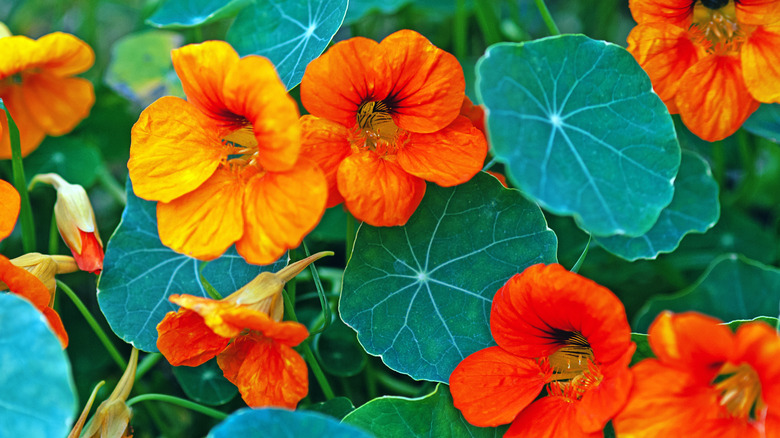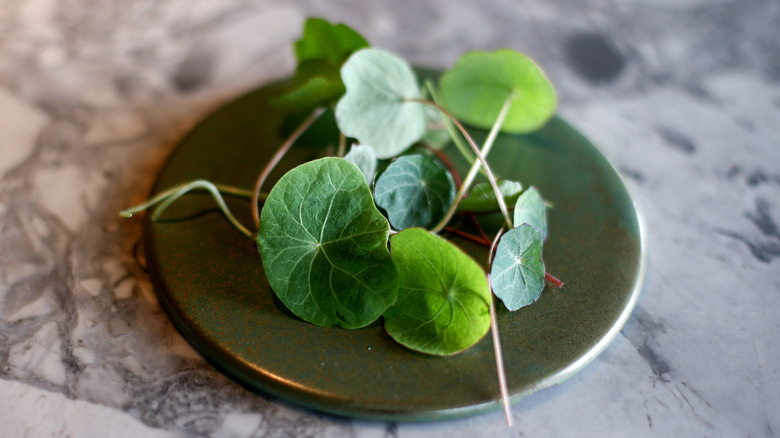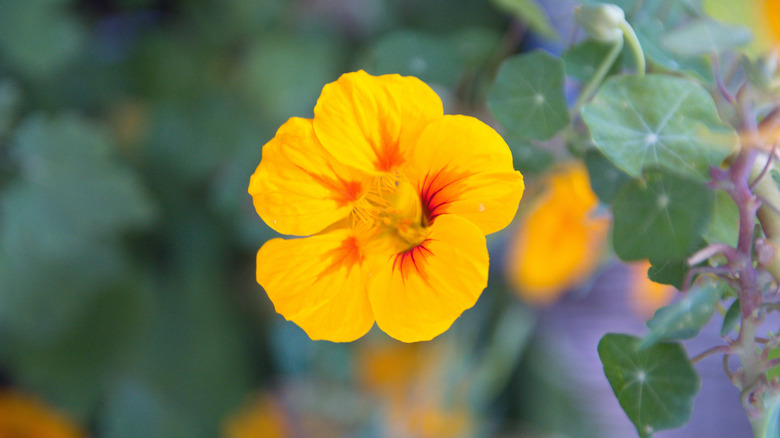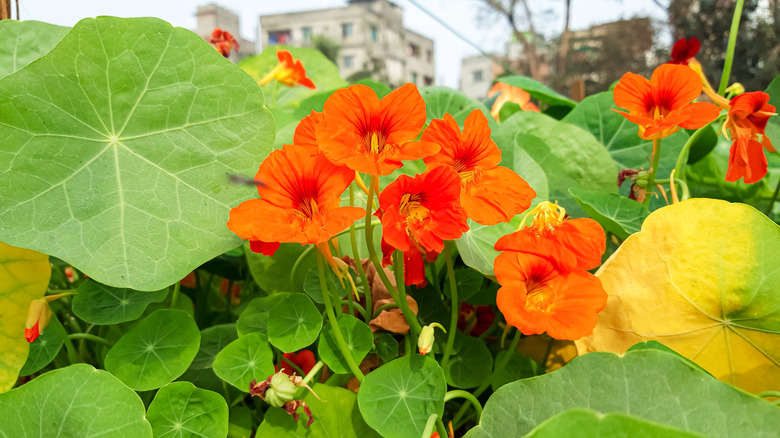What Are Nasturtiums And How Do You Eat Them?
As one of the most striking plants in all of nature, the nasturtium is truly one of a kind. Not only is it picturesque, it's also stunning in both appearance and flavor. Not to mention, the entire plant is edible, which is a rarity in many fruits and vegetables.
Nasturtiums — also called tropaeolum — are multifaceted and wildly versatile. A perennial plant, it hails from South America (Peru and Chile, more speicifcally). The flower was used by the Incas in both culinary and restorative functions, according to Spiceography. Discovered in the 1500s, according to The Bend Magazine, it is said that Spanish botanist Nicolas Monardes was the first person to bring nasturtium to Europe. He wrote fervently about the plant when cataloging his various observations and findings throughout South America, according to Urban Cultivator. Once the Spanish brought seeds of the colorful flowers from South America to Europe, cultivation of the plant then spread, beginning to be grown in various countries. The Kansas City Star notes that the plant was called "Indian Cress" in the 16th century, after being introduced to Europe.
What is the history of nasturtium and what does it taste like?
Named by Carolus Linnnaeus in the 1700s after noting the similarities between the flower's bright colors and tropaea — the helmets of Roman warriors — the Latin name is Tropaeolum, according to Mother Earth News. (The Kansas City Star also claims the name means trophy.) The Latin words nas and tortum — meaning nose and twist — supposedly are in reference to the reaction one might have upon first consuming a peppery, slightly bitter nasturtium, says Gardening Know How. The leaves are circular in shape, with light, gossamer veins that radiate from the center, while the flowers are shades of bright orange and red.
Nasturtium can be used in a myriad of ways. One of the best parts about nasturtium is that it's entirely edible — the flower, the seeds, the leaves, the stems. Its leaves taste peppery and piquant, with a subtly sweet vegetal undertone, almost like watercress, radish, or arugula. The flowers (perhaps unsurprisingly) have floral notes that are subtly fruit-like, while the stems have an herbaceous, allium-like flavor. Nasturtium can be used as you would use greens, herbs, or lettuces.
Don't forget the seeds! They're the most assertive-tasting component of the nasturtium plant. When pickled, the seeds are described as tasting similar to capers.
How do you cook with nasturtium?
Nasturtium can be eaten raw. It's delicious in soups, butters, purees, pastas, and broths, as well as in flavored oils, simple syrups, cocktails, vinaigrettes, and as a garnish. The flowers are the most mild component of the flower, and obviously add lovely, bright colors (often reds and oranges), while the leaves offer a deep, earthy green.
The flowers can be dried, crushed, and mixed with salt for a super-flavorful and beautifully hued seasoning salt. The leaves can act like grape leaves in dolmas, be sautéed with garlic and onion, or used in salads. It's important to note that the severity of the plant's peppery bite varies from garden to garden. Nasturtium is excellent in pasta or potato salads, as a pizza topping, in sandwiches, or as a cake decoration. It could be made into teas or even stirred into risottos. Supposedly during World War II, nasturtiums seeds were ground and used as a black pepper replacement, according to Gardening Know How.
Is nasturtium good for you?
Plant Food At Home notes that nasturtium has high levels of vitamins A, C, and D, and The Kansas City Star reports that it is said to be anti-cancerous and helpful in treating skin conditions and hair loss. The Institute of Culinary Education tells us that they're high in fiber, folate, and help prevent cardiovascular disease. Per The Lumberjack, they're antimicrobial, and Urban Cultivator states that they are a great source of manganese, iron, flavonoids, and beta carotene. Dr. Josh Axe states that they have anti-inflammatory capabilities and are packed with antioxidants.
Gardening Know How also notes that they are antibiotic, antiseptic, and antifungal, and they're helpful in treating cuts, scrapes, acne, and rashes, and they also act as a balm for an irritated digestive track. They're also very helpful for eye health. Clearly, they're pretty incredible. It should be noted, though, that the seeds do contain oxalic acid, so be certain not to consume them in large quantities (via Spiceography).
Beyond culinary and nutritional benefits, nasturtium makes lovely pressed flowers, and they also look stunning in your garden (and are helpful at thwarting weeds and pests). Another neat fact about nasturtiums is called the Elizabeth Linnaeus Phenomenon, which is a trick of the eyes in which the bright orange flowers appear to give off sparks or flashes of light at night time (via Nicholas JV).



